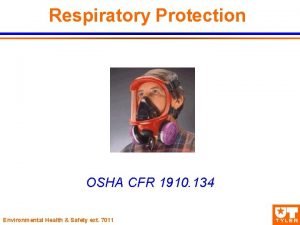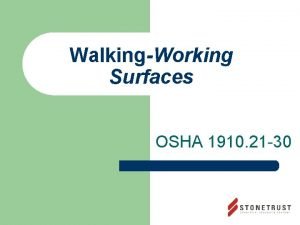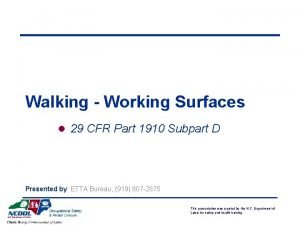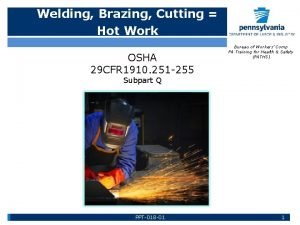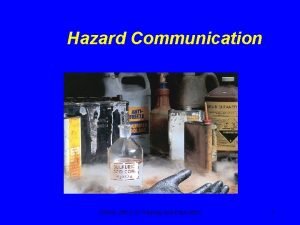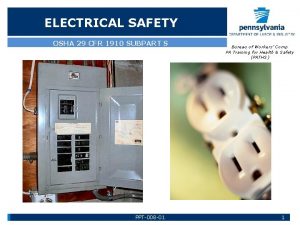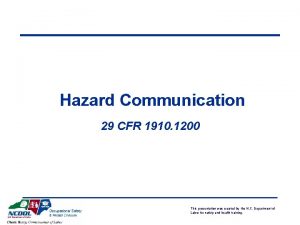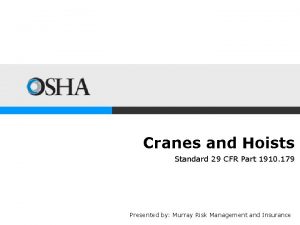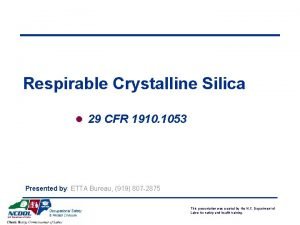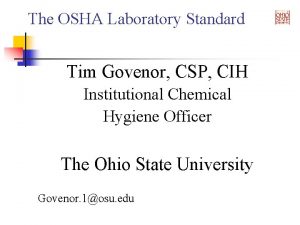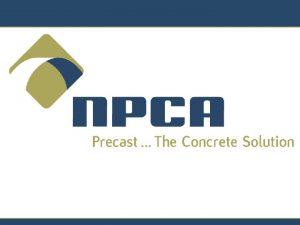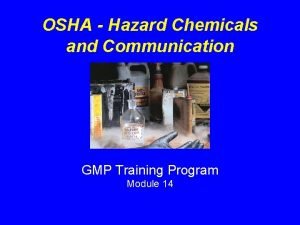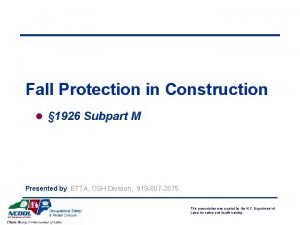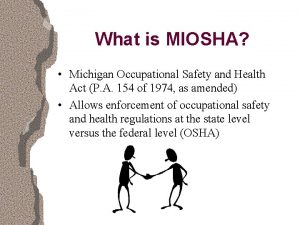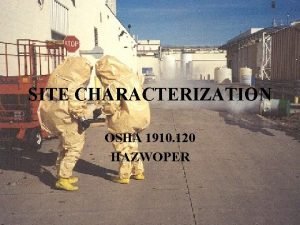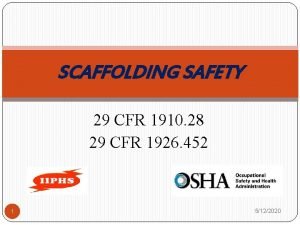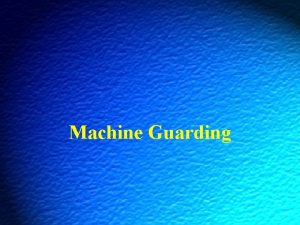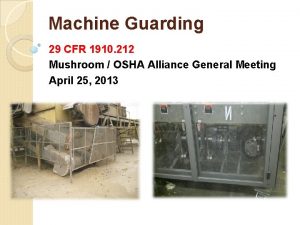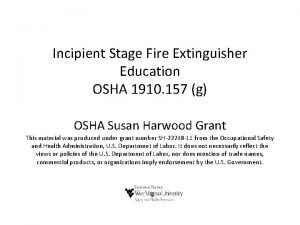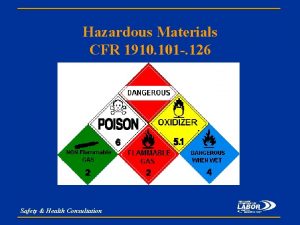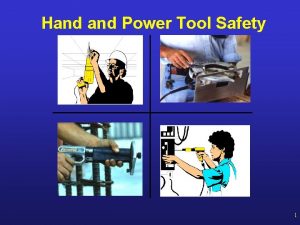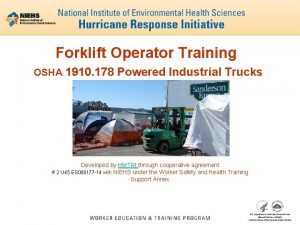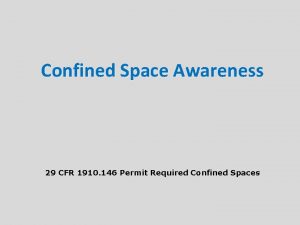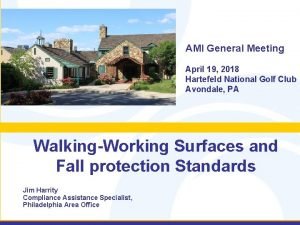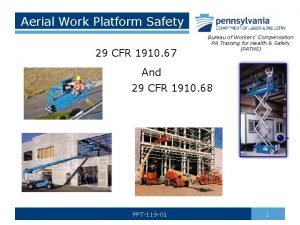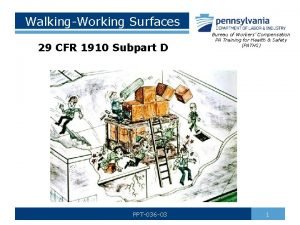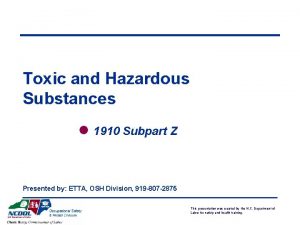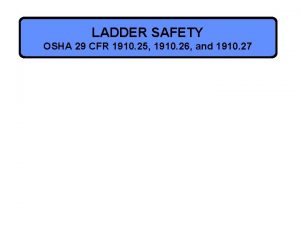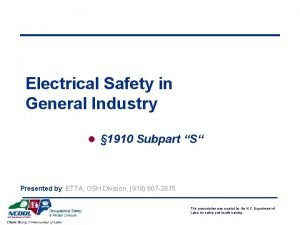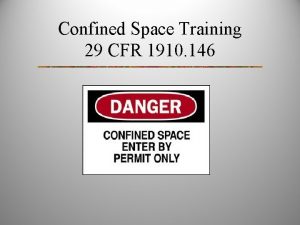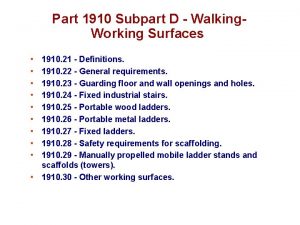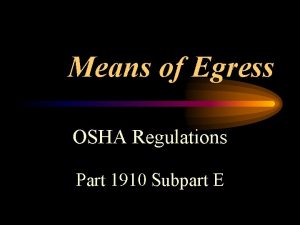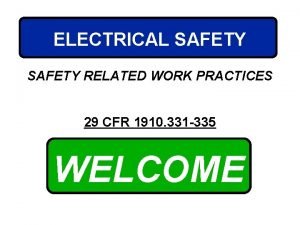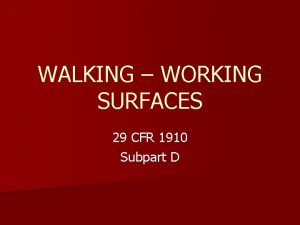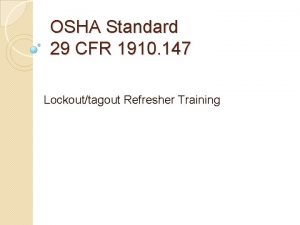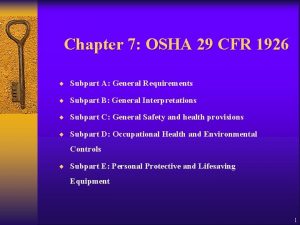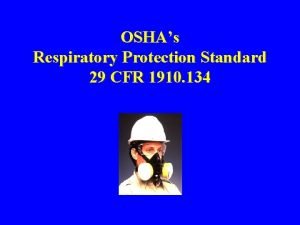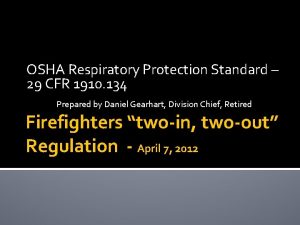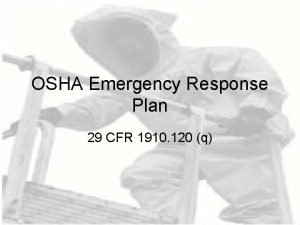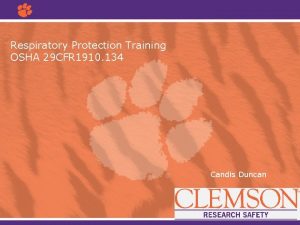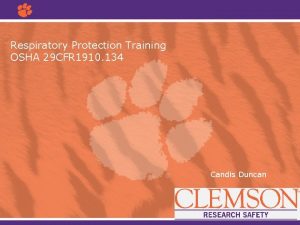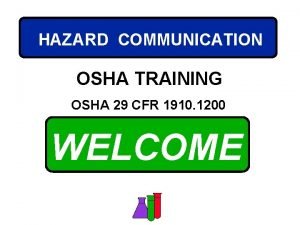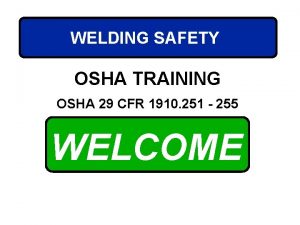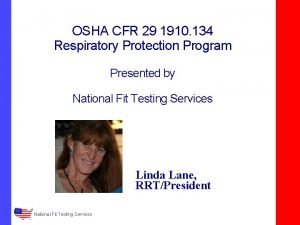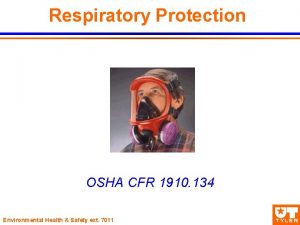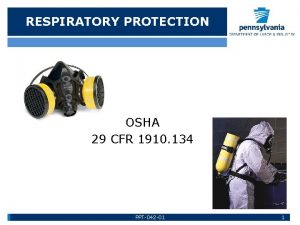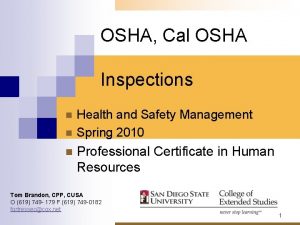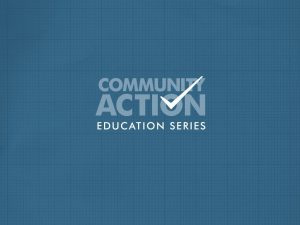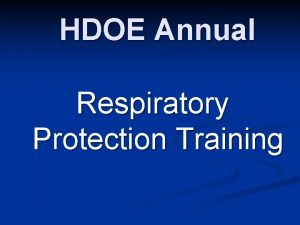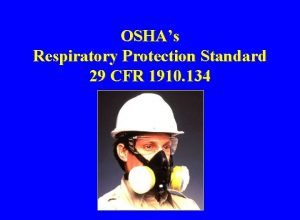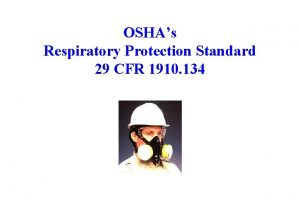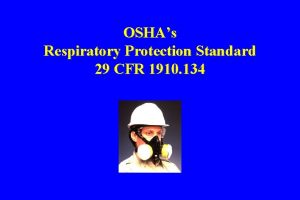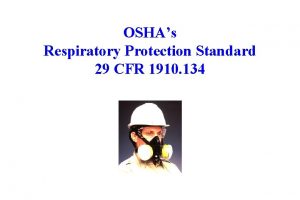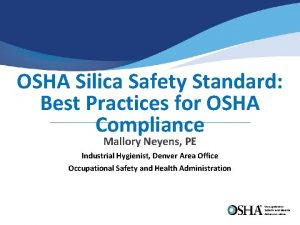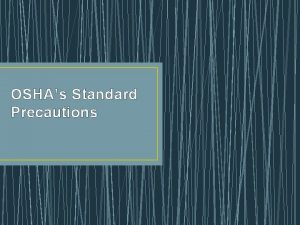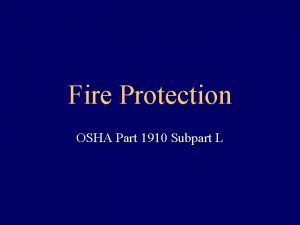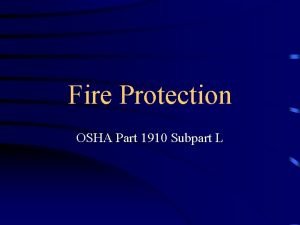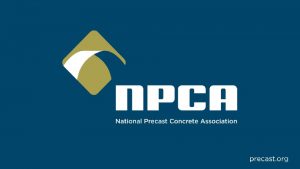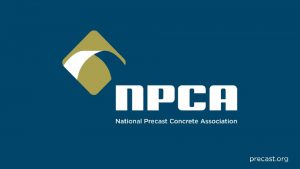RESPIRATORY PROTECTION TRAINING Information from OSHA Standard 1910










































- Slides: 42

RESPIRATORY PROTECTION TRAINING Information from OSHA Standard 1910. 134 And SCOTT 2. 2 SCBA Manual Lesson prepared by Scott Fitch 2/2003 1

OBJECTIVES Review Respiratory Protection Standard Explain: n Why SCBA use is necessary, n How improper fit/use can compromise firefighter health and safety, n Importance of maintenance of SCBA n 2

OBJECTIVES continued 4. Review limitations of SCBA And firefighter will be able to demonstrate the following: n How to properly Donn and Doff SCBA, n How to properly inspect SCBA, n How to check for face piece seal, n Proper use in emergency situations n Procedures for cleaning/disinfecting 3

OBJECTIVES continued And will be able to describe: n The medical signs and symptoms that may limit or prevent use of SCBA, n The general requirements of the revised Respiratory Protection Standard 4

SCBA Evaluation process! n Each firefighter will complete a written evaluation on this subject. n Each firefighter will demonstrate the proper donning, doffing and emergency procedures for the SCOTT Fifty SCBA 5

Program designed To help you protect your health and safety! 6

Why is SCBA use necessary? To protect the health of you, the firefighter 7

Describe the products of combustion 8

Products of combustion: n CO, CO 2, hydrogen cyanide, hydrogen chloride, phosgene, nitrogen oxide, nitrogen dioxide, particulate matter. n Combustion results in oxygen deficiency which alone is extremely dangerous! 9

What are limitations of SCBA n Limit on air supply n Limit to firefighting n To be used in hazardous materials situations, proper protective envelope is needed! 10

Improper use of SCBA n Through training, improper use can be avoided! n Tight face piece seal is vital to preventing exposure to contaminants! n A properly donned SCBA will minimize stress to the back. n SCBA is designed to protect lungs, not as a wheel chock! 11

Review components of SCOTT Fifty 2. 2 SCBA 12

Review operation of Pak-alert 1000 13

Review Bottle Change Procedure 14

Emergency Operation of SCBA n Per SCOTT, in the event of a malfunction, or suspected malfunction the following procedures should be implemented: 15

Emergency Operation of SCBA 1. Should the Vibralert alarm actuate during use and before the air supply is depleted to about 25% of full capacity, the primary reducer may have failed (system automatically transfers to the backup reducer). Notify partner and leave contaminated area immediately! 16

Emergency Operation of SCBA 2. Should the air supply be partially or completely cut off during use, or if you are unable to start the flow of air automatically, fully open the purge valve (red knob on regulator) by turning it clockwise. Notify partner and leave contaminated area immediately! 17

Emergency Operation of SCBA 3. Should air flow freely into the face piece, fully open the purge valve (red knob on regulator), partially close the cylinder valve by pushing in and rotating clockwise to regulate flow to satisfy user needs. Do not close cylinder completely! Notify partner and leave contaminated area immediately! 18

Emergency Operation of SCBA 4. In the unlikely event of blockage of airflow, or sudden complete loss of air supply, Notify partner and leave contaminated area immediately using Emergency Egress procedure set up by the FD (radio a mayday to IC)! 19

Procedure following SCBA failure: n Remove SCBA in a safe area. n Tag the SCBA out of service (include date, problem encountered, and individual/Group number reporting the problem). n Hold for service by an authorized SCOTT dealer! 20

Cold weather operations How does our SCBA hold up in sub freezing temperatures? 21

Low temperature operational concerns: n Per manufacturer, SCBA stored in temperatures above 32ºF. n Regulator may freeze during operations in sub-freezing temperatures (moisture from exhalation, or previous cleaning). n Place regulator inside turn out coat to thaw! 22

Inspection of SCBA 23

Inspection Procedure for SCBA n. Inspect for worn, aging rubber parts, fraying or wear of harness webbing, or damage to components (regulator, face piece, Pak Alert 1000) 24

Cleaning/Decontamination of SCBA Following FD guideline using the SCOTT Multiwash solution: n For face piece- 3 full pumps of solution on regulator side, 3 full pumps on inside of mask, wetting entire surface! Soak for 10 minutes and rinse with gentle, potable, running water. Shake off excess water, dry with lint free cloth. n 25

Cleaning/Decontamination of SCBA n For the Regulator: 3 full pumps of the SCOTT multi-wash solution into the regulator opening. Let sit for 10 minutes. Rinse using small quantity of clean, potable rinse water (very gently!). Note- forceful water will damage diaphragm on inside of regulator. Shake out excess water, let dry with room temp air via fan. 26

Cleaning of back pack: n Using warm water and a mild detergent, sponge the backpack off and rinse with low pressure water. Let pack air dry. 27

Pak-Alert 1000 Inspection n Inspect for damage, wear or cracks to enclosures, lenses and wire conduits. If problems found, tag and remove unit from service for repair by authorized SCOTT repair service. 28

Pak-Alert 1000 Inspection Before pressurizing SCBA, check manual alarm operation by pressing red button on face of pak-alert, then reset. n Open valve of cylinder, listen for 3 chirps and check green light for operation. n Check for pre-alert with SCBA pressurized and depressed donning switch and leave SCBA motionless n 29

Pak-Alert 1000 Inspection n Check pre-alert reset by moving SCBA. n Check manual reset or pre-alarm n Check full alarm reset n Check continuing operation following shut down of cylinder. n Turn off unit following bleed down of air. 30

Cleaning of Pak-Alert n Exterior may be cleaned by wiping with a damp sponge and thoroughly wiping it dry. Clean lense following each use to ensure maximum brightness of warning light. Note: Do not use solvent for cleaning exterior surfaces of this unit! 31

Pak-Alert Decontamination n If suspected of contamination by a hazardous substance, identify contaminant and remove, or contaminated component(s) must be replaced before next use. 32

Medical Evaluation n Confidential document that must be completed and submitted to the FD physician on an annual basis for each firefighter. n Used along with a physical by the FD physician to determine the ability for a firefighter to use an SCBA. 33

Medical limits for SCBA use: n Conditions that may prevent you from wearing SCBA at all. n Conditions that may be temporary that can affect your ability to safely use the SCBA. 34

Medical limits for SCBA use: n Should you experience any of the following signs or symptoms while using SCBA, notify your partner and immediately leave the hazard area. Seek immediate medical attention 35

Medical limitations for SCBA use: Any respiratory problem (I. e. bronchitis, asthma, respiratory infection, etc) n Heart conditions, chest pains n Back or shoulder problems n General weakness due to illness, fatigue. n Diabetic problem n Heat stress, exhaustion n 36

Firefighting demands great physical conditioning 37

Record keeping requirements The Fire District must maintain records of the following: 1. SCBA maintenance and operational checks. 2. Training and evaluation of knowledge of SCBA use by firefighters. 3. Annual fit testing of face piece. 4. Medical clearance to use SCBA 5. Breathing air quality certification 38

Review of OSHA 1910. 134 general requirements Evaluation of work place hazards n Medical evaluation with preliminary questionnaire. n Familiarization with SCBA design and limitations n Fit testing n 39

Review of OSHA 1910. 134 general requirements n Training and evaluation of firefighter ability to use SCBA n Training on emergency procedures n Cleaning, maintenance and storage n Record keeping 40

Practical use evaluation n Each firefighter will demonstrate the proper donning, doffing and emergency procedures for the SCOTT Fifty SCBA. n Each firefighter will demonstrate the proper bottle changing procedure for the SCBA. 41

In summary n OSHA 1910. 134 implemented to improve respiratory health of firefighters. n We’ve reviewed reason for use of SCBA n We’ve reviewed proper donning/doffing procedures n Bottle changing, inspection and cleaning procedures reviewed 42
 1910 134
1910 134 Housekeeping osha 1910
Housekeeping osha 1910 Osha racking requirements 1910
Osha racking requirements 1910 Osha hot work permit requirements 1910
Osha hot work permit requirements 1910 Osha cfr 1910 is the standard for______.
Osha cfr 1910 is the standard for______. 29 cfr 1910 subpart s
29 cfr 1910 subpart s 29 cfr1910.1200
29 cfr1910.1200 29 cfr part 1910
29 cfr part 1910 Osha silica standard 1910
Osha silica standard 1910 Osha laboratory standard 1910
Osha laboratory standard 1910 29cfr1910.1200
29cfr1910.1200 29 cfr 1910 section 1200
29 cfr 1910 section 1200 Osha hazard and ghs training regulation cfr 1910
Osha hazard and ghs training regulation cfr 1910 29 cfr 1926 subpart m
29 cfr 1926 subpart m What is miosha
What is miosha Three phases of site characterization
Three phases of site characterization Osha 1910 scaffolding inspection requirements
Osha 1910 scaffolding inspection requirements 29 cfr 1910
29 cfr 1910 Osha 1910 machine guarding
Osha 1910 machine guarding Osha conveyor safety 1910
Osha conveyor safety 1910 Incipient fire stage
Incipient fire stage 29 cfr 1910 hazardous materials
29 cfr 1910 hazardous materials Power tools must be fitted with guards and
Power tools must be fitted with guards and 29 cfr 1910 powered industrial trucks
29 cfr 1910 powered industrial trucks 29 cfr 1910 powered industrial trucks
29 cfr 1910 powered industrial trucks Osha 1910 section 146
Osha 1910 section 146 Osha 1910-27 certification
Osha 1910-27 certification Osha aerial lift 1910
Osha aerial lift 1910 Ppt-036
Ppt-036 29 cfr 1910 subpart z
29 cfr 1910 subpart z 1910 ladders
1910 ladders Osha ladder safety 1910
Osha ladder safety 1910 1910 subpart g
1910 subpart g 1910 146
1910 146 Osha 1910 subpart d
Osha 1910 subpart d Osha part 1910
Osha part 1910 29 cfr 1910
29 cfr 1910 Osha fixed ladder requirements 1910
Osha fixed ladder requirements 1910 Osha 1910 lockout tagout
Osha 1910 lockout tagout 1926 subpart c
1926 subpart c 29 cfr1910.134
29 cfr1910.134 Osha 1910-134
Osha 1910-134 Emergency response plan osha
Emergency response plan osha
